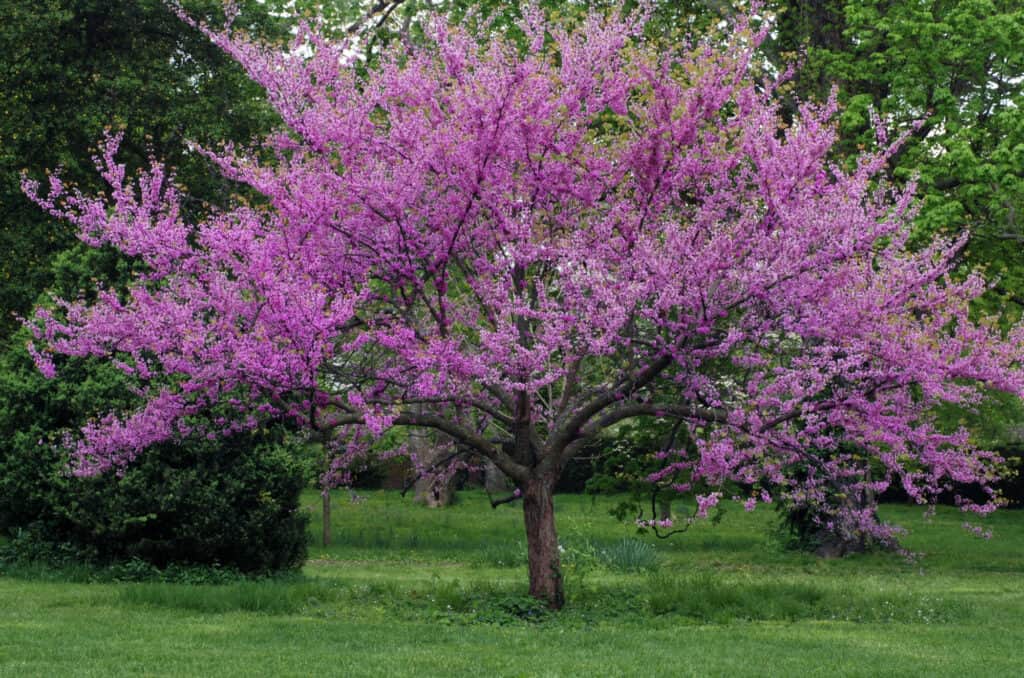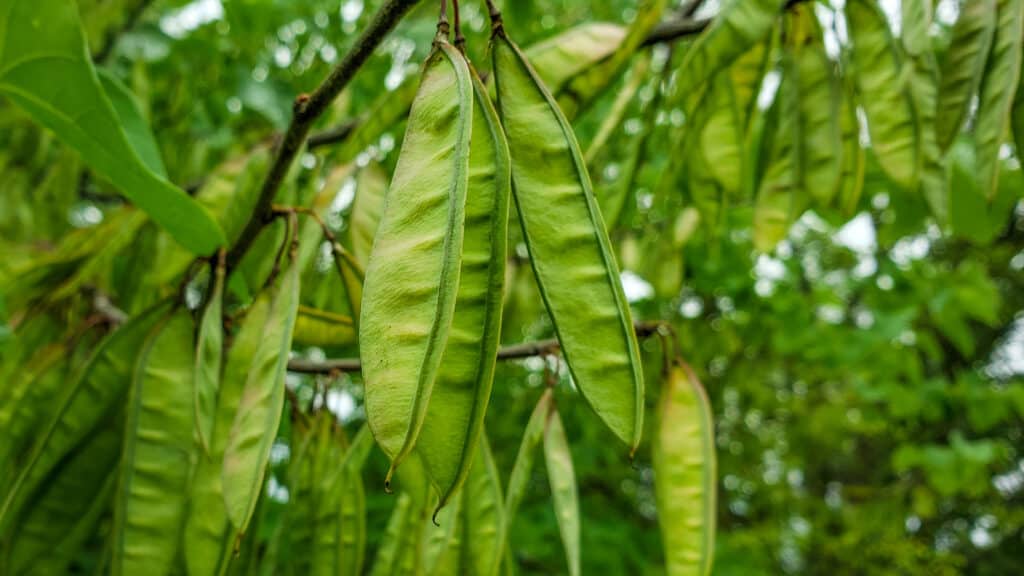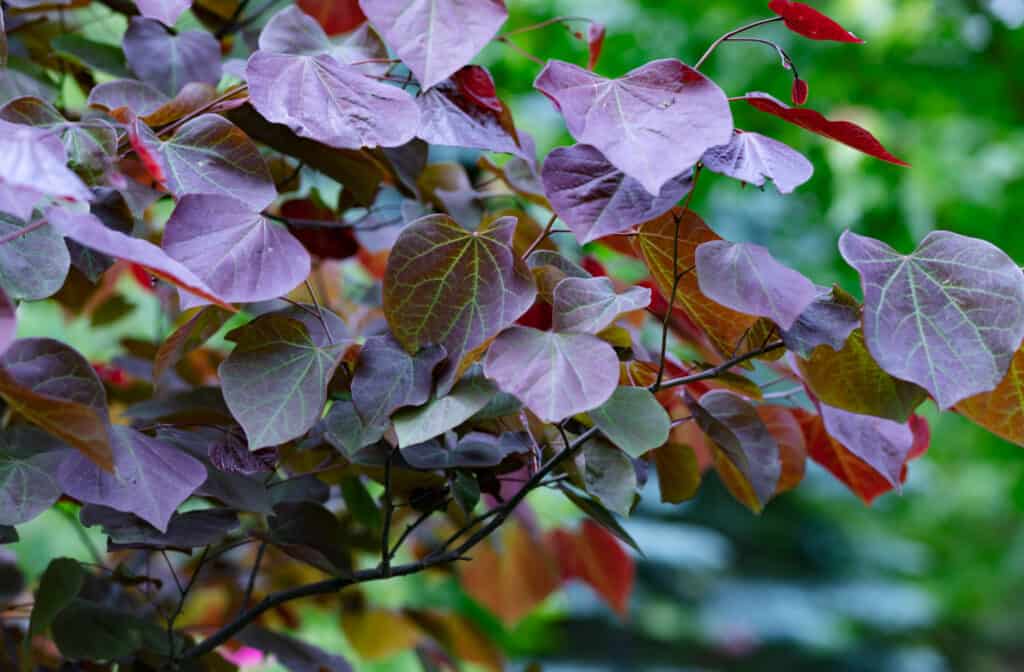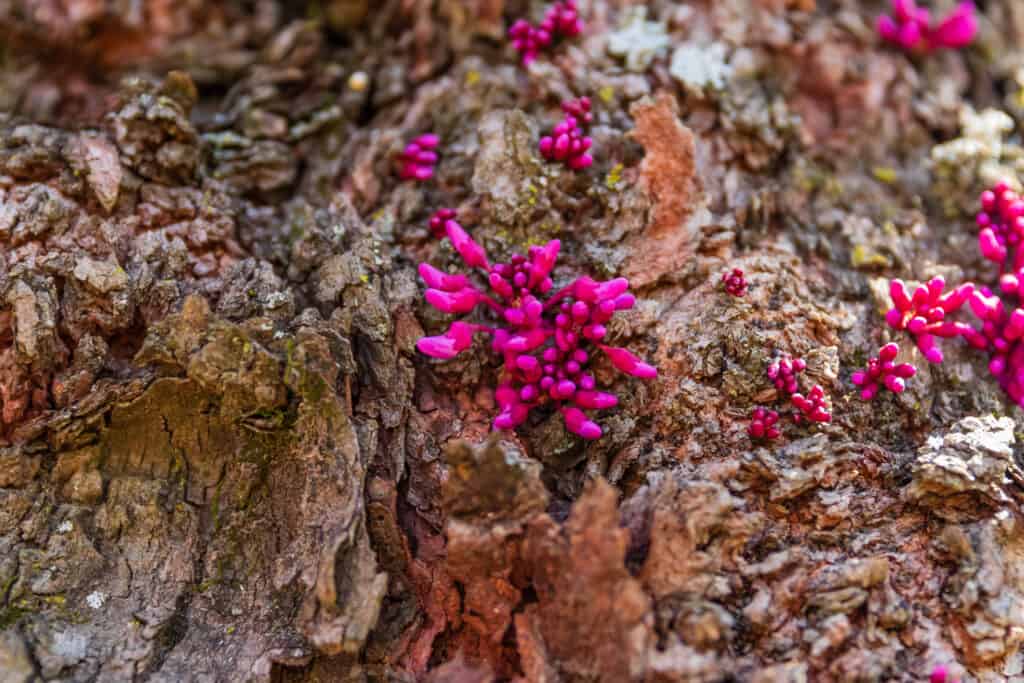Prior to the European colonization of North America, Indigenous Americans harvested the wood of redbud trees to construct weapons and tools. During the Colonial period in America, the newly arrived immigrants added redbud blossoms to their salads. These days, you’re likely to see redbud trees growing in yards around the neighborhood.
Redbuds are beloved and wildly popular with good reason. Redbud seed pods provide food for many different backyard animals, including birds, deer, and squirrels. They are also a vital source of pollen for honeybees and other pollinating insects. Most redbuds have delicate pink blossoms in springtime, bright green foliage in summer, and showy golden leaves in the fall.

Redbuds have delicate pink blossoms in springtime.
©Marie C Fields/Shutterstock.com
In North America there are at least 15 different species of redbud trees, among which are the Black Pearl and the Forest Pansy. So how are these two trees similar, and what sets these two varieties apart?
Black Pearl redbuds and Forest Pansy redbuds have a lot in common including:
- Both are variations of the Eastern redbud, Cercis canadensis
- Both grow in the Eastern part of North America
- Both have vibrant-colored, heart-shaped leaves
- Both blossom with pink flowers in the spring
However, Black Pearl and Forest Pansy redbuds also differ in significant ways. This article dives into learning about both the Black Pearl redbud and the Forest Pansy redbud. Let’s explore where each grows, its history, appearance, and cultivation.
Comparing the Black Pearl Redbud and the Forest Pansy Redbud
| Characteristic | Black Pearl Redbud | Forest Pansy Redbud |
|---|---|---|
| Scientific Name | Cercis canadensis ‘JN16’ Black Pearl | Cercis canadensis ‘Forest Pansy’ |
| Genus | Cercis | Cercis |
| Family | Fabaceae | Fabaceae |
| Common Name | Eastern redbud | Eastern redbud |
| Origin | Eastern North America | Eastern North America |
| Description of Plant | The Black Pearl redbud grows to be between 15 and 20 feet tall, with bright green leaves and lavender or pink-colored blooms that blossom in the spring. The bark is dark in color and grows darker with maturity. | The Forest Pansy redbud grows to be between 20 and 25 feet tall, with red or purple leaves and pink flowers. The bark is dark and develops more texture with maturity. |
| Habitat | The Black Pearl redbud grows in full sun to partial shade, with moderate war needs. Overall, it is a low-maintenance tree that grows well in well-drained, moderately fertile soil with consistent watering. | The Forest Pansy redbud grows in full sun to partial shade, with moderate water needs. It grows well in well-drained, moderately fertile soil and consistent watering. |
| USDA Hardiness Zone | Zones 5 to 9 | Zones 5 to 9 |
| Pests | Anthracnose, verticillium wilt, and Botryosphaeria canker, and insects such as borers, scale, leaf rollers, and leafhoppers. | Anthracnose, verticillium wilt, and Botryosphaeria canker, and insects such as borers, scale, leaf rollers, and leafhoppers. |
Descriptions of Black Pearl Redbud and Forest Pansy Redbud
Both Black Pearl and Forest Pansy are varieties of the Eastern redbud tree, Cercis canadensis, a member of the Fabaceae family. Fabaceae, also known as Leguminosae, is a family of flowering plants, including trees, shrubs, and herbaceous plants. Fabaceae includes more than 700 genera and approximately 20,000 different species. The Cersis genus includes nine species of deciduous trees and shrubs, which are known collectively as redbuds.
The Eastern redbud, Cercis canadensis, is one of two species of redbud trees native to North America. Redbuds are relatively small, deciduous trees that flower and produce seed in temperate zones across the globe. In North America, a number of different cultivars have been derived from the Eastern redbud. While various species will reproduce, cultivars are developed by scientists. Both the Black Pearl and Forest Pansy redbuds are among several different cultivars of the Eastern redbud, which are now grown across North America.
Redbud trees flower in early spring, blooming before their leaves emerge. These blossoms provide an early source of nectar for many different bee species. Next, hear-shaped leaves appear, and later in the summer, seed pods develop in clusters that look very similar to pea pods!

Redbud seed pods look very similar to pea pods.
©iStock.com/Lana2011
Black Pearl Redbud
Cercis canadensis ‘JN16’ Black Pearl is an Eastern redbud cultivar known for its dark, maroon-colored leaves and vibrant pink or purple blooms. The ‘JN16’ cultivar, which is often sold under the name of Black Pearl is a cross between Cercis canadensis, Ruby Falls, and Cercis canadensis ‘JN2’ The Rising Sun. Black Pearl redbuds grow to be between 15 and 20 feet tall. In the spring, the branches pop with pink or lavender-colored blossoms. The summer foliage is thick and leathery, with heart-shaped leaves that are between two and six inches long. The maroon leaves turn even darker, to an almost black color, in the fall.
In the United States, Black Pearl redbuds grow well in the same areas and under similar conditions as the Eastern redbud, in USDA hardiness Zones five to nine.
Forest Pansy Redbud
Cercis canadensis, Forest Pansy, is another Eastern redbud cultivar, with bright pink flowers in the spring. Forest Pansy redbuds grow taller than Black Pearl redbuds, reaching heights of 20 to 30 feet when mature. Like other Eastern redbuds, Forest Pansy has heart-shaped leaves. In the fall, Forest Pansy redbuds’ purple-to-marroon summer foliage turns orange to bright yellow.
The Forest Pansy also grows well in the same regions and conditions as the Eastern redbud, in USDA hardiness Zones six to eight.

Forest pansy redbud trees have deep purple leaves in the summer.
©Molly Shannon/Shutterstock.com
Key Differences
Though Black Pearl and Forest Pansy redbuds have quite a few similarities, they also have individual histories, appearances, and cultivation needs.
History
As mentioned earlier, redbud trees were used by Native Americans to construct bows and arrows, and as a food source for Colonial American settlers. The Eastern redbud is one of the most widely-planted ornamental trees in North America. The Eastern redbud is also one of the most important flowering trees in the garden. Yes, the flower buds and opened flowers are colorful and add vibrancy and beauty to a yard for several weeks each spring. However, these trees are also an important source of pollen for bees. Eastern redbuds are often one of their earliest sources of nectar.
Appearance
Black Pearl redbud trees grow to be between 15 and 20 feet tall. Their canopy is roughly equivalent to their height. In the spring, the Black Pearl grows flower buds that blossom into lavender and pink-colored blooms. Once the blooms begin to fade, leaves of dark purple to nearly black begin to emerge. The tree’s bark is dark and grows darker as the tree ages. The Black Pearl is set apart from other redbuds by having leaves that have great depth of color, maintained throughout the entire growing season. Unlike the Forest Pansy, Black Pearl keeps this dark purple color throughout the year.
The Forest Pansy redbud grows taller in comparison to the Black Pearl, reaching heights of 20 to 25 feet, with red or purple leaves and pink flowers. Like the Black Pearl redbud, the bark is dark and develops more texture with maturity. However, its leaves will turn from red or purple into an autumnal red-orange color.

The bark of Black Pearl redbuds is dark and develops more texture as they mature..
©iStock.com/Marine2844
Growing Conditions
Most eastern redbud trees are found growing south of Connecticut and New York and north of Central Florida. You can also find them growing in Michigan, Southern Wisconsin, Iowa, Eastern Nebraska, Kansas, Oklahoma, and even in Eastern Texas. Their geographic range speaks to the Eastern redbud’s tolerance for a variety of conditions. In the North, Eastern redbuds are typically found growing in woodlands, along streams and rivers, on the border of forests, and in glades. In the South, Eastern redbuds are found in the rich, nutrient-dense, silty soil along streams and rivers, in the deep woods, and at the bottom of ravines.
Growing Conditions for Black Pearl Redbuds
Black Pearl redbud trees are relatively easy to grow. They prefer moist, well-drained soil ,and will tolerate full to partial sun. Black Pearl redbuds grow to be up to 20 feet tall, with a similarly large canopy, so, when planting, space trees at least 25 feet apart to give them plenty of room to grow. You will be rewarded for you for your efforts, as your Black Pearl redbud is sure to attracts songbirds, bees, and butterflies.
Potential pests include Japanese beetles, treehoppers, leafhoppers, caterpillars, borers, webworms and scale. These challenges, and other potential diseases, can be avoided by maintaining a consistent watering schedule, fertilizing soil appropriately, and pruning the tree’s branches regularly.
Growing Conditions for Forest Pansy Redbuds
Like Black Pearl redbuds, home landscapers will find that Forest Pansy redbud trees are relatively easy to grow and will thrive in moist but well-drained soil. Your tree will thrive in full to partial sun and is drought tolerant once the tree has become established. Like its relative, the Black Pearl, your Forest Pansy is likely to attract songbirds, butterflies, and bees.
Potential pests include Japanese beetles, treehoppers, leafhoppers, caterpillars, borers, webworms, and scale. Maintaining a consistent wateing schedule, fertilizing soil appropriately, and pruning the tree’s branches regularly, all help keep it healthy.
Black Pearl Redbuds vs. Forest Pansy Redbuds: Uses
Because Black Pearl and Forest Pansy redbuds are relatively easy to grow and blossom with beautiful springtime flowers, landscapers often suggest planting them with tulips, which bloom around the same time. In general, redbuds need little care and are low-maintenance ornamental trees. Regardless of your preference, you can’t go wrong when planting either Black Pearl redbuds or Forest Pansy redbuds, both of which are delightful additions to a home landscape!
Up Next:
- Forest Pansy Redbud vs. Eastern Redbud
- How Many Trees Are In The World?
- Discover the Different Types of Spruce Trees
The photo featured at the top of this post is © Molly Shannon/Shutterstock.com
Sources
- University of Florida, Available here: https://hort.ifas.ufl.edu/database/documents/pdf/tree_fact_sheets/cercanc.pdf
- The Spruce, Available here: https://www.thespruce.com/forest-pansy-redbud-growing-guide-5199776
- Gardenia, Available here: https://www.gardenia.net/plant/cercis-canadensis-black-pearl
- North Carolina Extension, Available here: https://plants.ces.ncsu.edu/plants/cercis-chinensis/
Thank you for reading! Have some feedback for us? Contact the AZ Animals editorial team.






